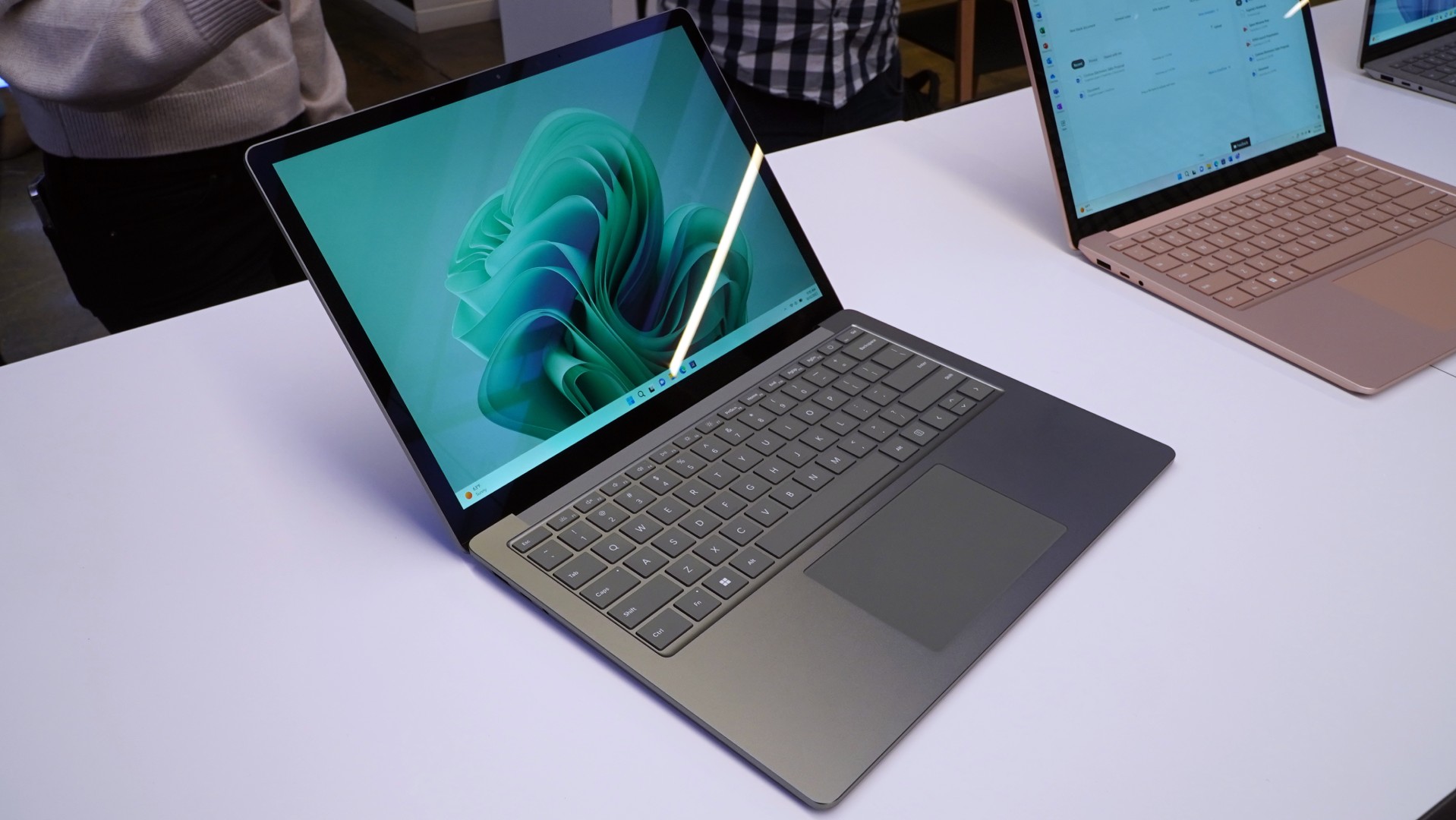Expert's Rating
Pros
- Performance is surprisingly competitive
- Vivid, bright screen
- Cellular connectivity for on-the-go work
- Fantastic battery life
- New Windows Studio Effects generally work well
Cons
- eSIM connectivity had issues
- Audio isn’t as rich as earlier tablets
- Inking isn’t quite as good
- Expensive
- No headphone jack
- Arm processor has some compatibility issues with games
Our Verdict
If you’re in the market for an always-connected Windows tablet for office work, we’d recommend you take a look at the Surface Pro 9 (5G).
Best Prices Today: Microsoft Surface Pro 9 (5G)
We recommend that you consider buying the Microsoft Surface Pro 9 (5G) Windows tablet, with an Arm chip—not an Intel or AMD chip—inside. That’s a first for us, and we hope it’s not the last.
Read reviews of the Surface Pro 9 with a large grain of salt, because there are two significantly different products hiding under the same brand name. The Surface Pro 9 is built on an Intel 12th-gen Core chip (Alder Lake), while the Surface Pro 9 (5G) uses a separate SQ3 chip co-developed by Qualcomm to Microsoft’s specifications. We’re reviewing the Surface Pro 9 (5G) here.
The Surface Pro 9 (5G) is essentially the Surface Pro X, now renamed and brought under the Surface Pro 9 brand umbrella. Inside it is the SQ3, an Arm chip that’s technically incompatible with the X86 architecture of Intel’s Core and AMD’s Ryzen processors, but can run most Windows apps both via a special Arm-optimized version of Windows 11 plus a special code interpreter.
What it boils down to is this: The Surface Pro 9 (5G) should offer somewhat more battery life and somewhat less performance than the Core version of the tablet, based on our tests. But it’s not that much less, and that’s the surprise. Nevertheless, there are still application compatibility issues if you wander too far from its mission: handling day-to-day Office tasks and browsing via Microsoft Edge.
The Surface Pro 9 (5G) is also the only SP9 to include a 5G radio inside, meaning that you’ll enjoy always-on connectivity once you leave the range of the nearest Wi-Fi router. We’re also told that Microsoft does not plan to sell a 5G version of the Surface Pro 9 with a Core chip inside, either — if you want an always-connected Surface Pro 9, the Surface Pro 9 (5G) is it.
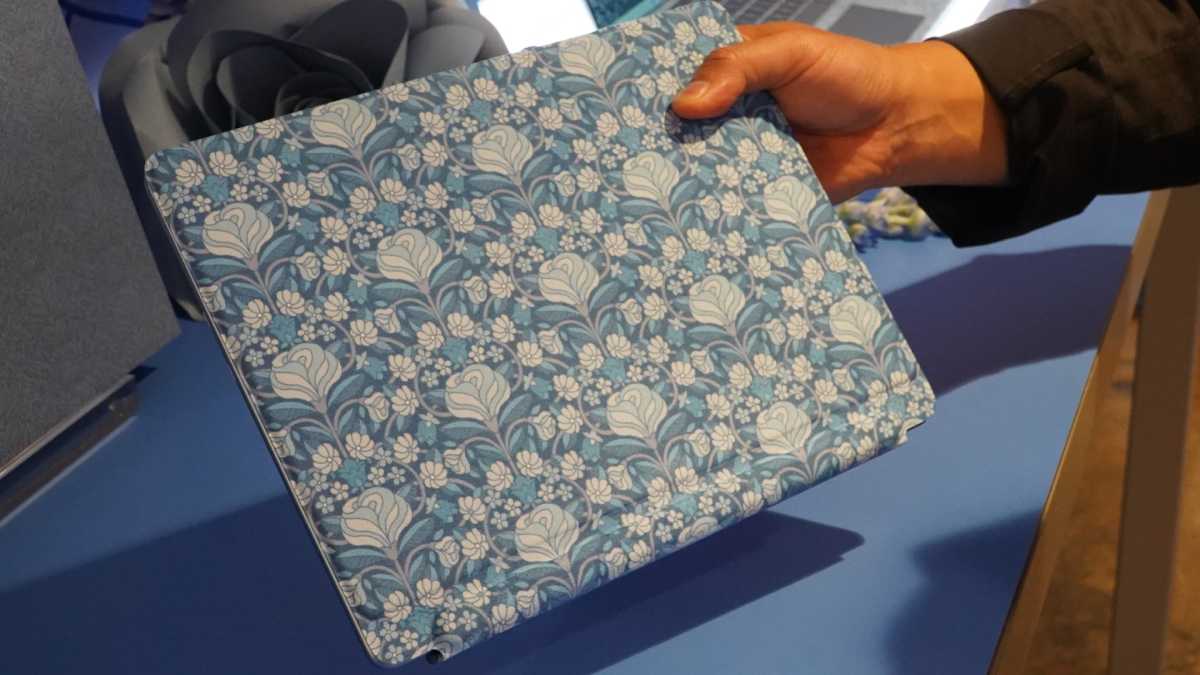
A special Liberty Floral keyboard is available in limited quantities to celebrate the Surface line’s 10th anniversary.
Michael Crider/IDG
Unlike the Surface Pro 9, the Surface Pro 9 (5G) does not include a pair of Thunderbolt 4 USB-C ports, which usually requires an Intel processor. Instead, the Surface Pro 9 (5G) includes standard USB-C ports rated at the vanilla 10Gbps spec instead. This matters in two ways: first, you won’t be able to use a Thunderbolt dock to expand this tablet’s I/O capabilities. You also won’t be able to use a powered Thunderbolt dock to charge the tablet either, and will have to depend on the 39W charger to charge the tablet through the Surface Connect port.
This is not an enormous issue; you can use Microsoft’s Surface Dock 2, the upcoming Microsoft Audio Dock, or an inexpensive USB-C dongle to provide some I/O expansion capabilities, and the in-box charger works just fine. But it’s another difference between the two.
Otherwise, aside from shaving a sliver off of the chassis weight, the Surface Pro 9 is essentially the same as the Surface Pro 8: the same design, with a Surface Pro Signature Keyboard (sold separately) which can tuck the optional Surface Slim Pen 2 (usually bundled with the Signature Keyboard) into its recharging cubby. Two new color options are available: Sapphire and Forest, with a special Liberty floral blue Surface Pro 9 color option in limited quantities to celebrate the tenth anniversary of the Surface tablet.
Microsoft has continued to offer two sub-versions of the Surface Pro 9 and Surface Pro 9 (5G), which vary by operating system. Our review unit of the Surface Pro 9 (5G), supplied by Microsoft, uses Windows 11 Home. An optional Surface Pro 9 (5G) for Business ships with both Windows 11 Pro. Business customers also enjoy better support options.
Surface Pro 9 (5G) features and specs
- Display: 13-inch PixelSense Flow (2880×1920, 267 PPI) up to 120Hz with dynamic refresh rate
- Processor: Surface Pro 9 (consumer): 12th-gen Core i5-1235U, Core i7-1255U; Surface Pro 9 for Business: Core i5-1245U, Core i7-1265U; Surface Pro 9 with 5G: Microsoft 3.00GHz SQ3
- Graphics: Surface Pro 9: Iris Xe (Core i5, i7); Surface Pro 9 with 5G: SQ3 Adreno 8cx Gen 3
- Memory: Surface Pro 9: 8/16/32GB LPDDR5 RAM; Surface Pro 9 with 5G: 8/16GB LPDDR4X RAM
- Storage: 128GB/256GB/512GB/1TB removable SSD; Surface Pro 9 with 5G: 128GB/256GB/512GB removable SSD
- Ports: Surface Pro 9 (5G): 2 USB-C 10Gbps; Surface Pro 9: 2 USB-C (USB 4.0/Thunderbolt 4). Both SP9 models include 1 Surface Connect port, 1 Surface Keyboard Port
- Security: Camera (Windows Hello)
- Camera: Surface Pro 9: 5Mpixel/1080p (user-facing), 10MP/1080p and 4K video (rear-facing); Surface Pro 9 with 5G: same, but with Windows Studio Effects
- Battery: Design capacity: 46.5Wh; Full capacity, 49.2Wh
- Wireless: Both: Wi-Fi 6 (802.11ax), Bluetooth 5.1; Surface Pro 9 with 5G: see below
- Operating system: Consumer, both Surface Pro 9 versions: Windows 11 Home; Business, Surface Pro 9: Windows 10 Pro or Windows 11 Pro; Surface Pro 9 with 5G: Windows 11 Pro
- Dimensions: 11.3 x 8.2 x 0.37 inches
- Weight: Surface Pro 9: 1.94 pounds; Surface Pro 9 with 5G: 1.95 pounds (mmWave); 1.94 pounds (Sub6)
- Color: Platinum, Graphite, Sapphire, Forest, Liberty (limited supplies)
- Price: Surface Pro 9 (consumer): $999 to $2,599.99, depending on configuration; Surface Pro 9 with 5G (consumer): $1,299.99 to $1,899.99; Surface Pro 9 for Business: $1,099.99 to $2,699.99; Surface Pro 9 with 5G for Business: $1,399.99 to $1,899.99 ($1,599.99 as tested)
- Optional accessories: Surface Slim Pen 2: $97 on sale at Amazon; Surface Pro Signature Keyboard: on sale at Amazon for $149.99
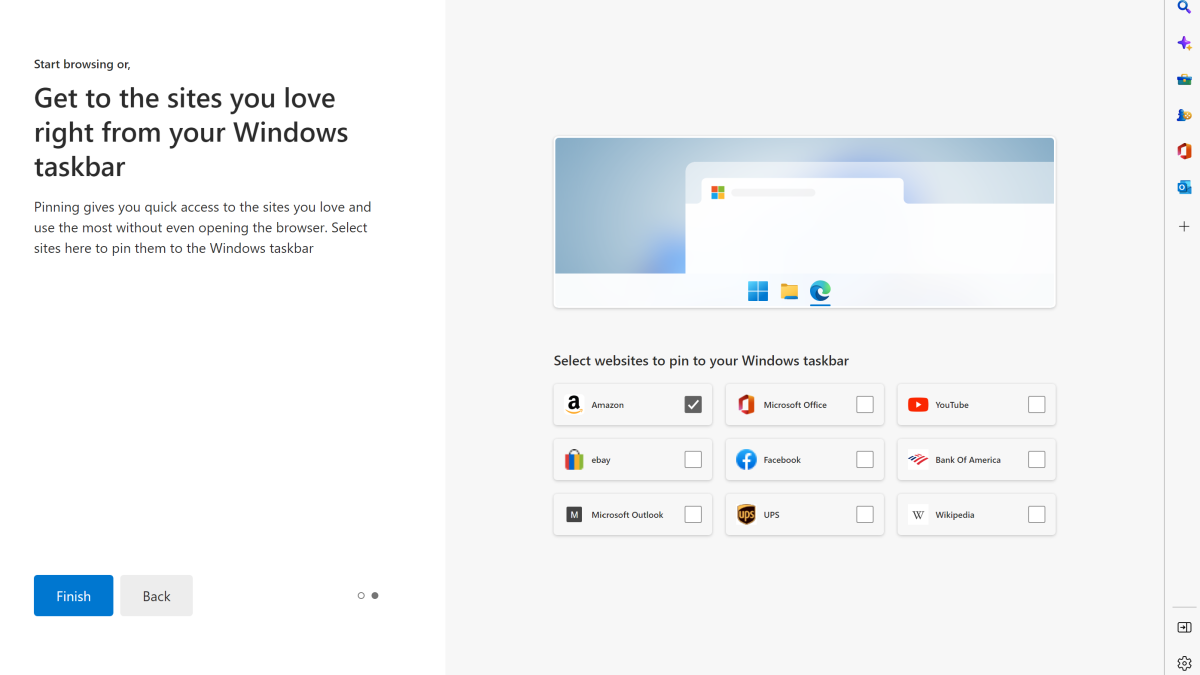
Mark Hachman / IDG
Microsoft Surface Pro 9 (5G): Out of the box
Microsoft sent us a Surface Pro Signature Keyboard in what appears to be the Sapphire color, along with the Surface Slim Pen 2.
Microsoft’s setup process doesn’t seem to differ too much from what Windows 11 now asks of you. You’ll still need a Microsoft account to proceed, though that opens the door for automatic installation of Microsoft 365 (Office 365) as well as migrating apps and settings from any other previous installations. Expect to see the Surface app pop up randomly early on, asking you to set up your Surface Slim Pen 2, including questions about what hand you ink with as well as a general overview of how the pen works. Inking is far more fundamental to the Surface Pro experience than, say, the Surface Laptop 5.
The power button and volume rocker have wandered about the top and sides of the Surface Pro over the last few generations. The Surface Pro 9 (5G) returns to the design of the Surface Pro 7+, with the power and volume rocker on top, next to one another.
The Surface Pro 9 (5G), like its 5G-less cousin, is a Windows tablet, with the SP9’s traditional kickstand that allows it to recline just 15 degrees or so off of the horizontal. The Surface Pro 9 experience is part consumption, as the lightweight tablet and kickstand allows it to be propped up in all sorts of non-traditional locations; part creation, via inking on the tablet; and part productivity, with the magnetically attached Signature keyboard allowing it to emulate a traditional clamshell notebook. It does all of these pretty well.
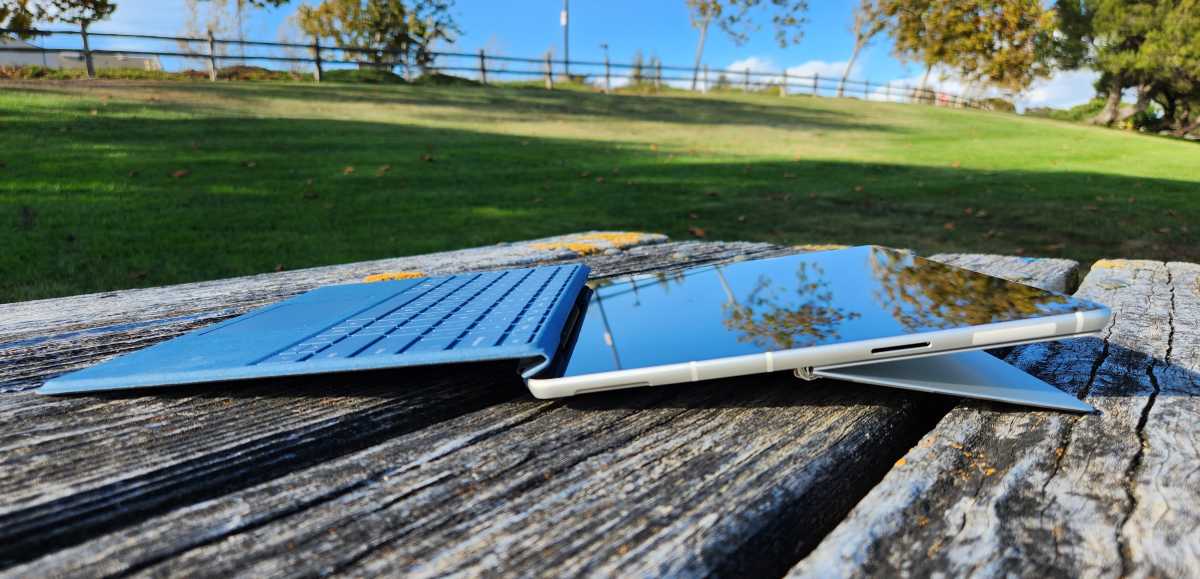
Mark Hachman / IDG
In general, the Surface Pro tablets do best on a flat surface, versus a typical clamshell laptop which can perch on your lap. Otherwise, you’ll have to hold the 13-inch SP9 tablet up, grasping it by the rather large bezels on the sides. The display matches the Surface Pro 8, which increased the display size slightly, with better resolution than rival tablets from Dell and others. You might think by now that Microsoft would use some sort of AI intelligence to sense which fingers are merely holding the tablet, and which are interacting with it. That’s not the case, and everything looks a bit antiquated as a result.
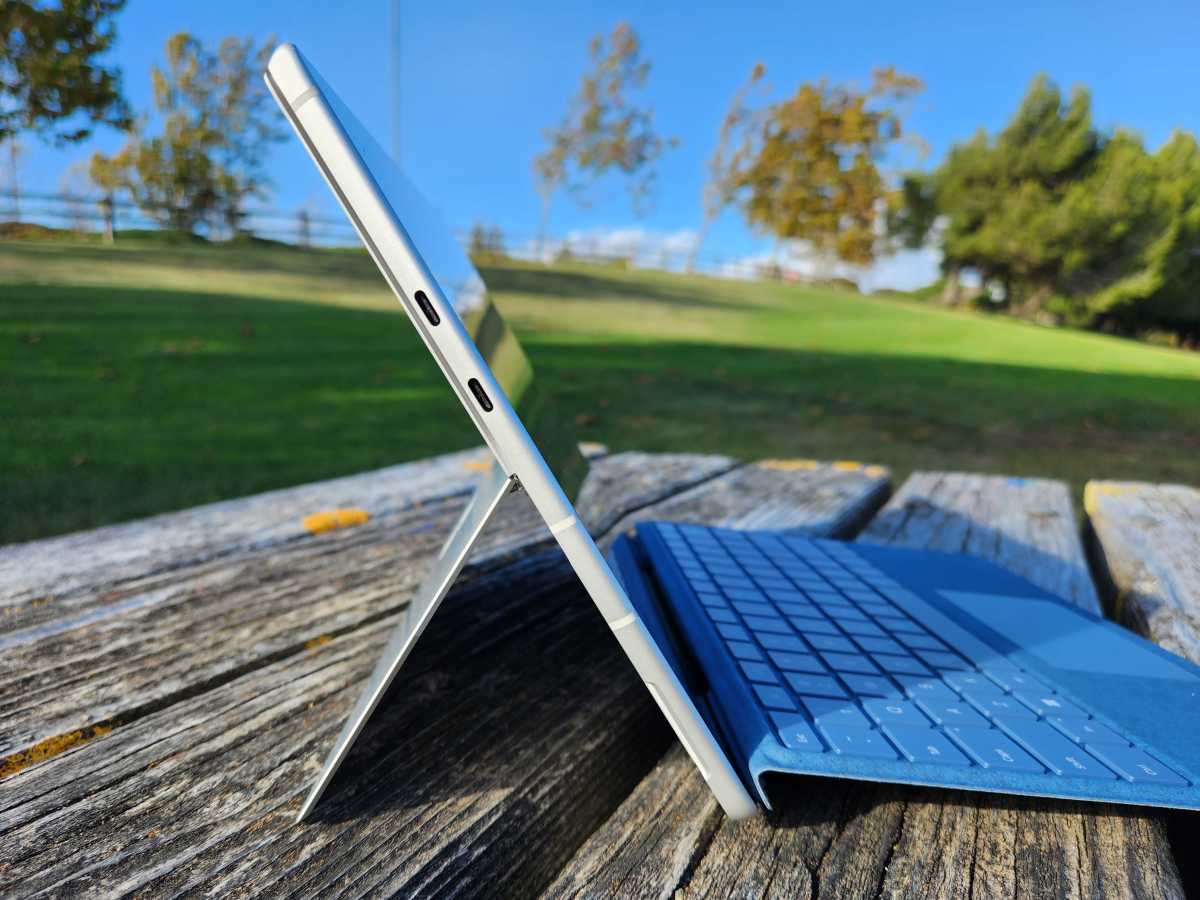
Mark Hachman / IDG
When comparing it to other tablets like the Apple iPad or the Samsung Galaxy Tab series, the Surface Pro 9 is hard-pressed to hold its own. But in the Windows space, versus traditional laptops, the SP9 stands out, with a display resolution that pushes past 1440p and with excellent pixel density. The PixelSense Flow screen continues to be simply beautiful, with a dynamic 120Hz option for improved smoothness and inking.
According to our colorimeter, the Surface Pro 9 (5g) puts out an extremely bright 443 nits of screen luminance and covers much of the sRGB color gamut as well. That’s about ten more nits than the Surface Pro 8 pushed out, and should allow you to work in the shade, if not daylight. That’s ideal for an on-the-go, connected tablet.
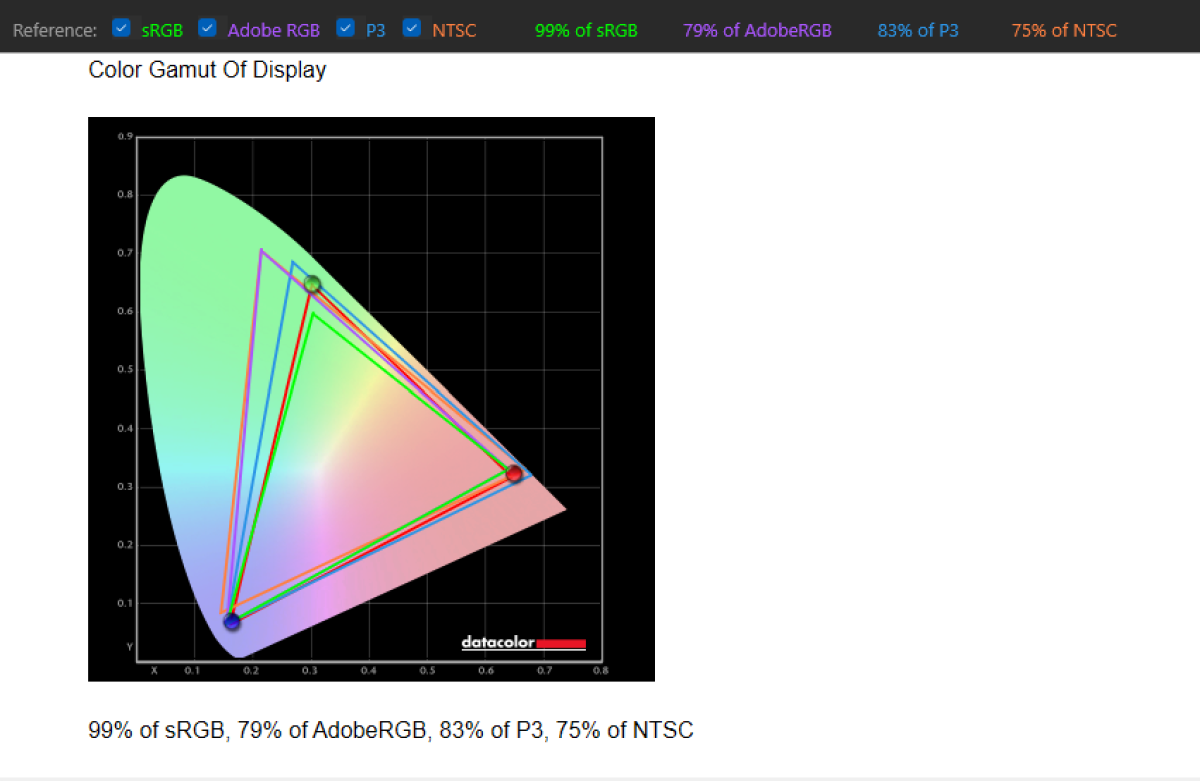
Mark Hachman / IDG
Microsoft’s 5G tablet foregoes Dolby Vision IQ, a visual display improvement that the new Surface Laptop 5 includes but this device does not.
The Surface Pro 9 (5G) uses an Arm processor, typically much more power-efficient than an X86 chip. It’s fanless, and justifiably so; we could hardly feel any warmth on the rear of the tablet, either after copying files, decompressing them, or running workloads. The tablet only became marginally warm when connecting it to a secondary display via a USB-C cable.

Mark Hachman / IDG
Unlike the Surface Laptop 5 (or virtually any other product that uses an Intel or AMD X86 processor) the Windows’ performance settings have no effect. With an X86 chip, you can get significantly increased performance for free; with the Surface Pro 9 (5G) the settings are there, but are just for show.
We understand that while Microsoft would have liked to add in Thunderbolt, that just didn’t happen. We have a 4K test display that includes a USB-C input, and it powered that display without any problems at all. (Naturally, it can only run its internal display at 120Hz, however.) Microsoft phased out the microSD card slot in earlier Surface Pro models, but you can “replace” that with a separate USB-C dongle.
How is the Surface Pro 9 (5G) to type on?
Microsoft’s Surface Pro Signature Keyboards haven’t changed that much in the last few years, save for the addition of the charging cubby for the Slim Pen 2. Yes, the magnetic connector holding the keyboard to the tablet does secure the tablet well enough to use it on your lap, but you’ll probably prefer to use it on a desk or tabletop in most cases. While you’ll probably prefer the stability of typing on a clamshell laptop, the inclined Signature Keyboard is absolutely usable for everyday use.
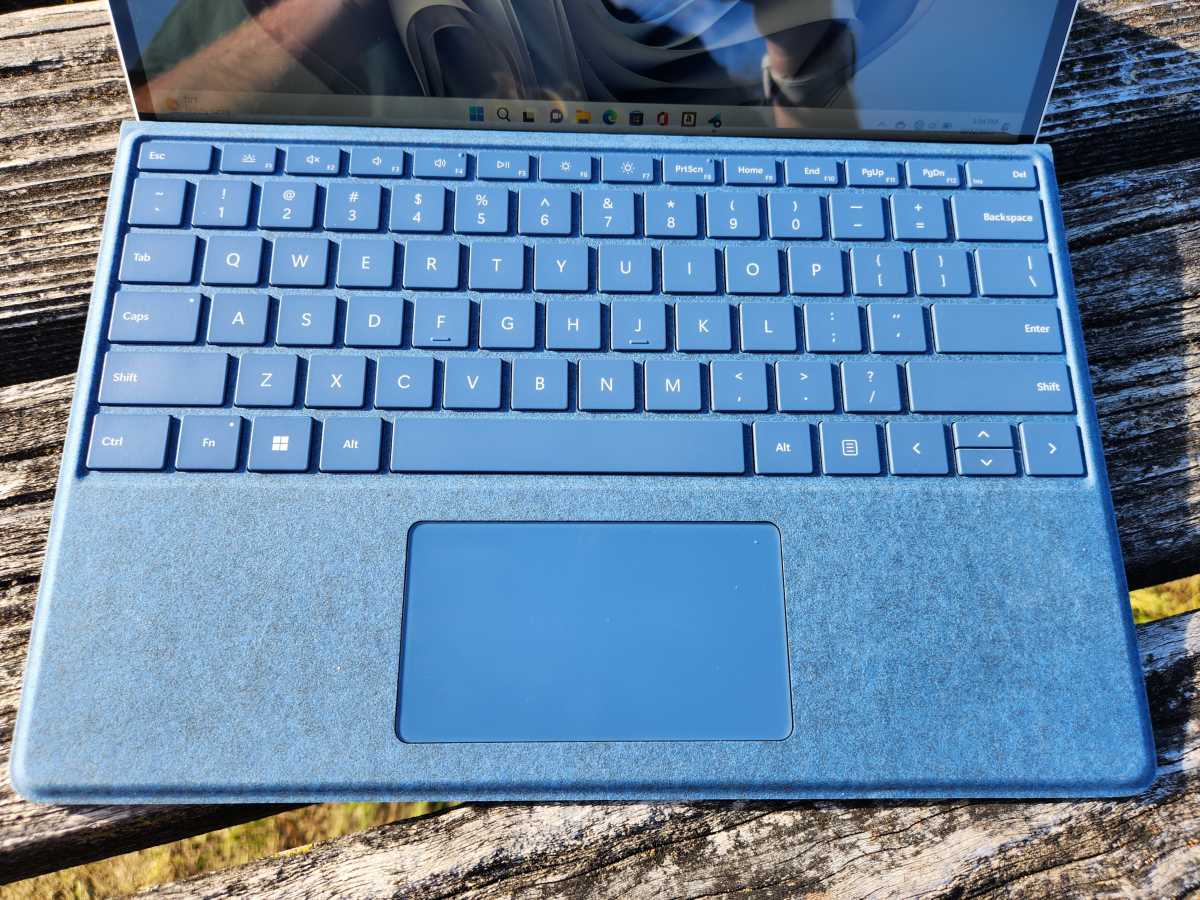
Mark Hachman / IDG
What happened to the Surface Pro 9’s headphone jack?
The Surface Pro 9 (5G)’s speakers provide a soft but balanced soundscape with noticeably less volume than prior generations. Put against the Surface Pro 8, there’s simply little point of comparison: previous Surface tablets have punched above their weight in terms of audio quality, and the Surface Pro 9 (5G) seems to be trading on that legacy with less to back it up. Yes, the specs say that there’s still the same 2W speakers inside it, but I find that hard to believe.
In fact, the Surface Pro 8 has a toggle switch within the Windows 11 Settings menu to toggle on audio enhancements. The Surface Pro 9 (5G) lacks that feature, and frankly sounds almost identical to the SP8 with that switch toggled off. Using headphones, though, thankfully rectifies those flaws, and my Google Pixel earbuds sounded terrific.
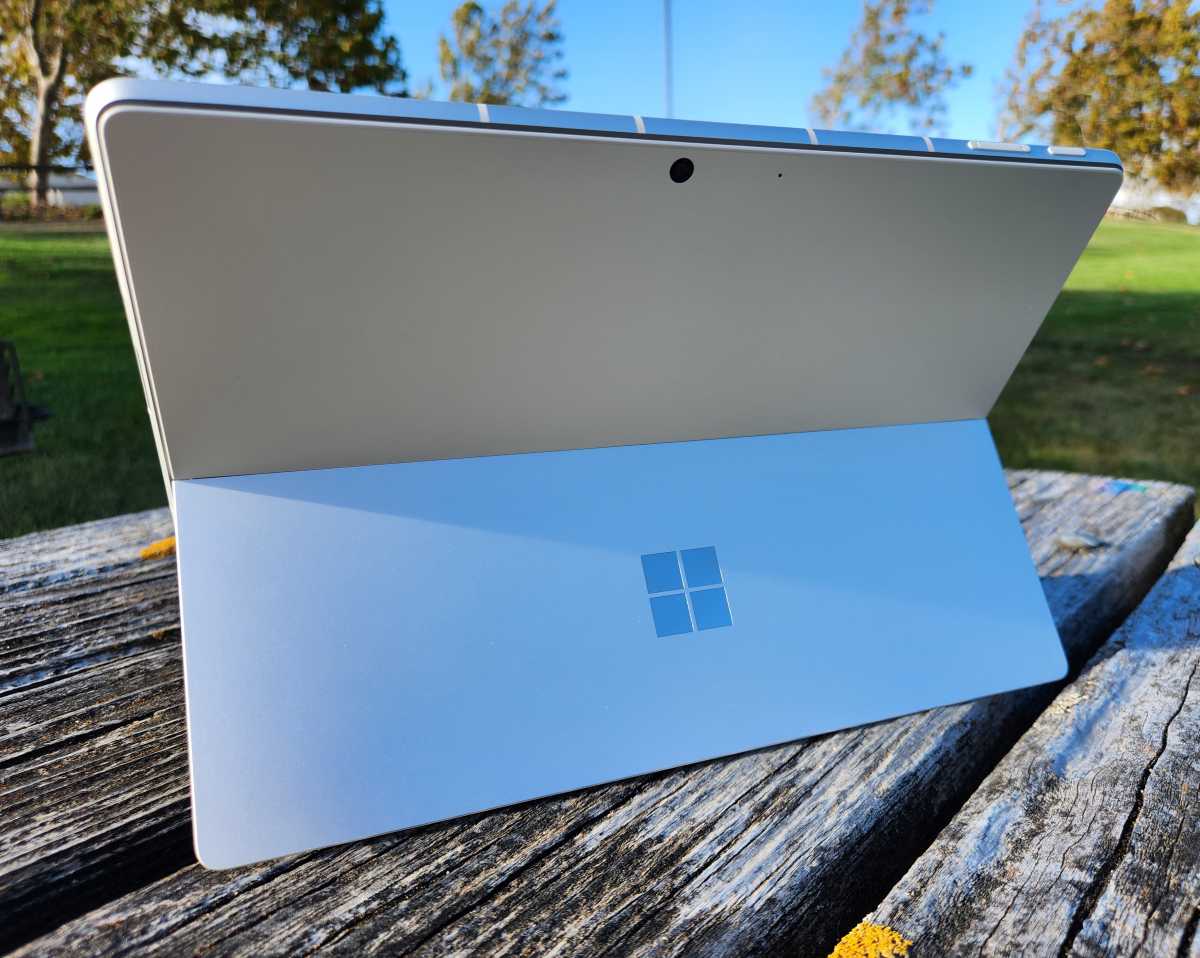
Mark Hachman / IDG
It’s worth noting, though that those are Pixel USB-C wired earbuds. Why? Because the Surface Pro 9 (5G) has joined the ranks of those devices that have killed off the headphone jack alongside the Surface Pro X — still a black mark in my book. I don’t want to have to charge Bluetooth earbuds to use my tablet. If you feel differently, that’s fine.
The Surface Pro 9 (5G)’s webcam, however, is one of the device’s highlights. First, the Surface Pro family has always used a 1080p webcam, and they’re usually among the best of any laptop or tablet, anywhere. Though the webcam image shot with the camera is a bit soft, the image quality, color, and lighting is quite good. I typically capture these webcam images in the morning, but this was captured in the afternoon, with side light. It’s still very well done.

Mark Hachman / IDG
But there’s another reason to buy the Surface Pro 9 (5G), and that’s what Microsoft calls Windows Studio Effects. Inexplicably, they’re buried within the Settings menu (Settings > Bluetooth & devices > Cameras > Surface Camera front) but they’re offered (right now) on no other Surface device Microsoft offers.
Specifically, Windows Studio Effects offer three features: background effects (specifically blurring), Eye Contact, and automatic framing. While other applications offer background blurring, the key is that Windows offers this as a general control, so it isn’t dependent on the app itself. (It’s a little unclear whether an app’s effects will be able to override this or not.) Microsoft offers two blurs: a “portrait” blur that vaguely blurs the background, and a deeper “standard” blur” that makes the background largely unrecognizable. These are all previewable within Settings, by the way.
Interestingly, both models of the Surface Pro 9 ship with a webcam with a 4-degree tilt, which we have to assume contributes to its capability for automatic framing.
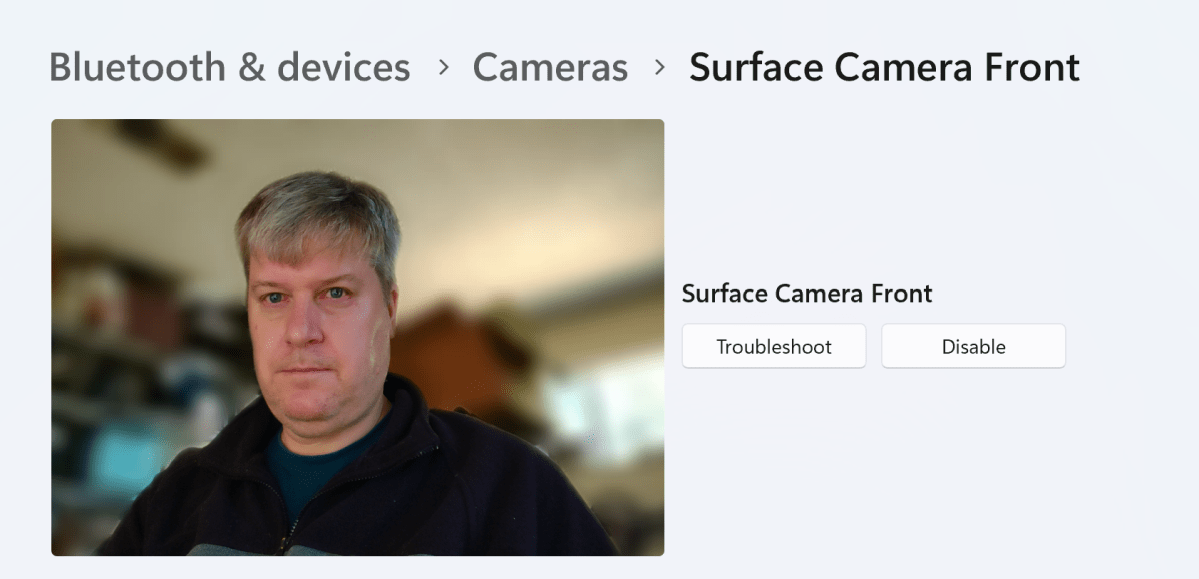
Mark Hachman / IDG
Eye Contact is a feature that, like FaceTime for Apple’s iOS, attempts to use AI to fix your gaze on the camera, no matter if you’re actually looking at something else. Again, this is a Windows control, so it should be active in Teams, Zoom, Google Meet, and other apps. But it’s not previewable, so you’ll have to trust (ha!) that you’ll look as if you’re actually paying attention. (It didn’t work with a phone movie I recorded of my face, with my eyes darting this way and that.) That’s a bit risky during those group meetings or staff calls, so play it safe until you can test it out with a friend.
Automatic framing does work, however. In a perfect world, automatic framing would work as a sort of face tracking, tracking your face as you move around. And it does! — within some limits. The webcam does a nice job of identifying your face and zooming in to it. If you’re seated at your desk during a call, it’s unlikely that this will make a difference. But if you stand up or slide your chair back, automatic framing should step in. We captured automatic framing in action to create this GIF, below.
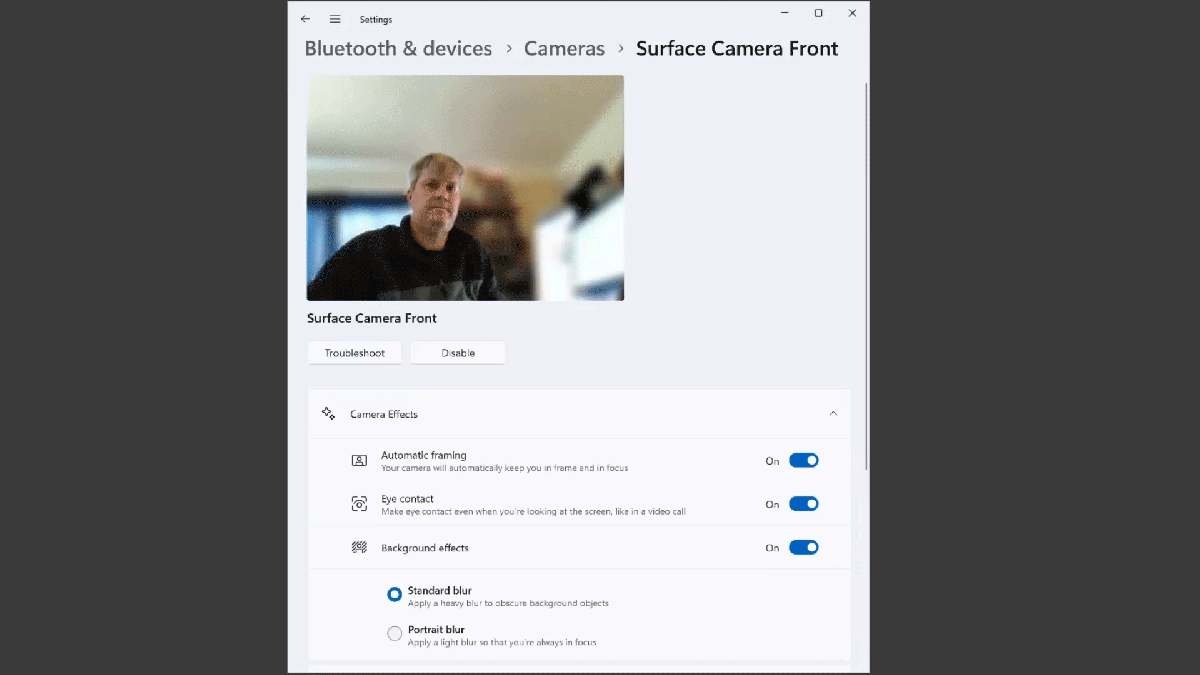
Mark Hachman / IDG
How is the Surface Pro 9 (5G) for inking?
The Surface Pro 9 (5G) continues to support the tablet well, even maximally reclined, for inking. Microsoft has also finally nailed the pen’s design, too: though you’ll need to buy a Surface Pro Signature Keyboard, the way that the flat Surface Slim Pen 2 conceals itself within it and charges when not in use is just about perfect. (Make sure not to buy the Slim Pen 2 separately without the keyboard, as the standalone Pen 2 doesn’t come with a charger.)
One of the few things we haven’t tested was how long the Slim Pen 2 lasts; Microsoft says that the pen’s internal rechargeable battery can last up to 15 hours, which should be just fine before it has to be returned to its cubby to recharge. We haven’t had any complaints, nor do the users we interact with online.
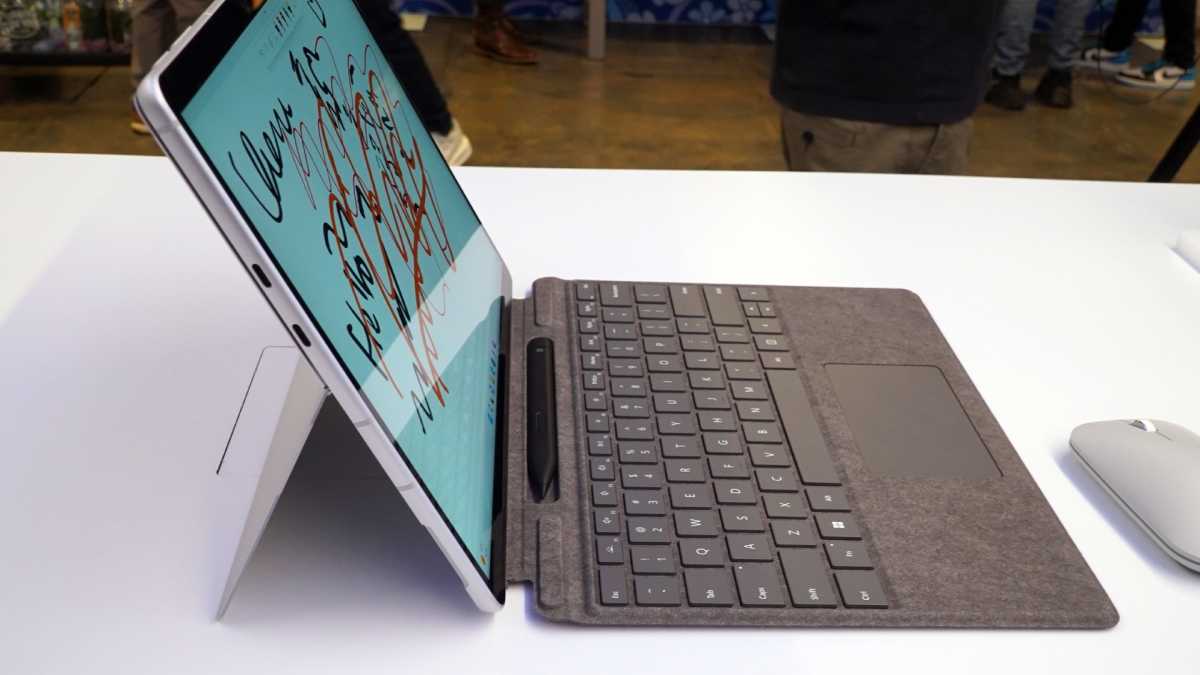
Michael Crider/IDG
The Slim Pen 2’s flat shape is a bit awkward to use, though the redesigned Pen 2 has a sharper nib, allowing for more precision. It also applies 4,096 levels of pressure sensitivity. I really can’t tell how accurate this all is, though we tested the inking capabilities by inking a series of straight lines. below, with a straight edge. The pen-tablet interaction on most tablets introduces jitter (wobble) under certain situations, especially when inking slowly on a diagonal. The Surface Pro 8 offered an exceptional inking experience, though I don’t think the Surface Pro 9 (5G) is as good, as there seems to be more jitter when inking slowly and diagonally, which is where it creeps in. There’s no noticeable ink offset, though, as the ink “flows” directly underneath the nib.
Again, Microsoft seems to have oversold the haptic feedback. When inking on the tablet your fingers should receive a bit of resistance, like inking on paper, I really couldn’t feel it.

Mark Hachman / IDG
Cellular performance
One of the selling points of the Surface Pro 9 (5G) is its ability to connect on the go. Microsoft provides two options: either you can insert a physical SIM card into the back of the tablet, via a pop-out door that also houses the replaceable SSD, or you can sign up with one of two built-in eSIM providers and use that instead. If you choose the latter (as I did), you don’t need a physical SIM card at all. That’s certainly the more convenient option.
Unfortunately, I’m not sure it’s the most effective. I signed up for a 1Gbyte, 7-day eSIM plan with GigSky, one of the built-in providers, for $9.99. Neither GigSky nor Ubigi, the other provider, offer 5G connectivity—unfortunate considering this SP9 includes “5G” in its name. There’s also no obvious provision to save your GigSky password via the browser, and I hadn’t installed a password manager.
Across my test sites, I received decent connectivity, but not quite up to snuff to a Samsung Galaxy S22 5G phone. In two locations with middling to poor signal quality, the eSIM not only failed to connect but asked me to activate the eSIM again, after I’d paid for and actually used the eSIM at another location in town.

Mark Hachman / IDG
I received a maximum of 268Mbits down and 1.69Mbits up within sight of the cellular tower, and progressively worse results elsewhere — 132 Mbits and 76Mbits. That’s not that shabby, and more than enough to work or stream a movie, as I did. Otherwise, without a 5G offering, and with middling bandwidth, I’d be tempted to look into what my provider would offer to wirelessly tether my phone, or what it would cost for a secondary physical SIM.
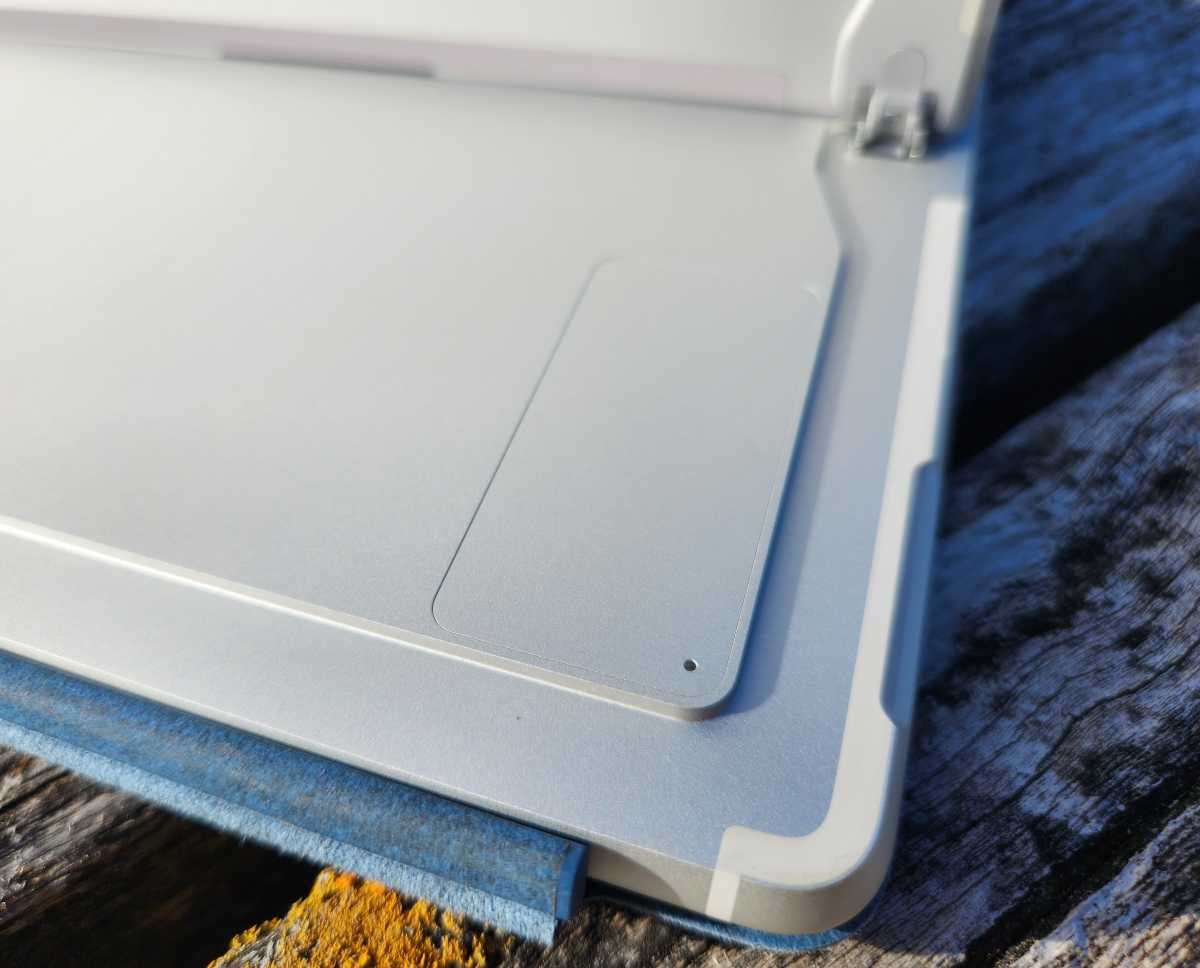
Mark Hachman / IDG
How good is the Surface Pro 9 (5G) performance?
The short answer? Not that bad, surprisingly.
Normally, we’d use a standard suite of benchmarks to evaluate the Surface Pro 9 (5G). But the fact that there’s an Arm chip inside complicates matters. While the SQ3 Arm chip runs most applications, it doesn’t run all of them, and it’s this unexpected “What? Really?” response that can still turn off potential buyers.
For most common applications, though the Surface Pro 9 (5G) should run most everything you’d throw at it: Office apps, Microsoft Edge and competing browsers, even the nitty-gritty apps like the Windows Command Line app. (Earlier versions didn’t always do this.) Just don’t expect to play games; the tablet “will not install some games and CAD software, and some third-party drivers or antivirus software,” according to Microsoft—games with OpenGL 1.2 or above or with anti-cheat software, essentially.
Streaming our test 4K60 test YouTube stream looked gorgeous on the tablet’s screen, thanks to the great color fidelity. But YouTube only delivered a 1440×810 stream, though it didn’t drop a single frame. The Netflix and Hulu apps worked as expected. You can download and run Google Chrome, if you’d like.
We’d normally provide links to comparative tablets, but there really aren’t any right now. We can recommend reading our review of the Lenovo ThinkPad X13s Gen 1, which uses the 8cx Gen 3 and should be roughly comparable to the Surface Pro 9 (5G) and its SQ3 chip. We don’t have the Surface Pro 9 with a Core chip inside of it to compare to.
Normally, we’d test our suite of benchmarks that measures general day-to-day app performance, with CPU tests, and so on. But some of those applications still won’t work on Arm.
Therefore, we’re forced to play the junior varsity: a PCMark 10 Apps test suite by Underwriter Laboratories that measures how well the tablet loads and uses Microsoft Office apps; a related UL test, 3DMark, which tracks 3D performance; and a browser-based benchmark that tries to fill in the gaps in how well the tablet will handle other applications.
One of our test applications that has run previously, PCMark 8’s Creative workload, simply refused to run after numerous attempts. It’s one of the frustrations of this platform.
But there has been a surprising amount of improvement in the Snapdragon infrastructure. Again, it’s unclear whether or not that our limited test suite is just topping out in terms of theoretical performance, but we were surprised at how well Snapdragon caught up and even exceeded a Core chip.
Case in point: WebXPRT 3. It’s a legacy Web app, even passed over by the developer in favor of a new version. WebXPRT performs photo editing, spreadsheet work, digital scanning, and so on, using tools like Web Workers and Javascript. And yes, it topped the Surface Laptop 5, Microsoft’s clamshell notebook that uses the 12th-gen Core (Alder Lake) chip.
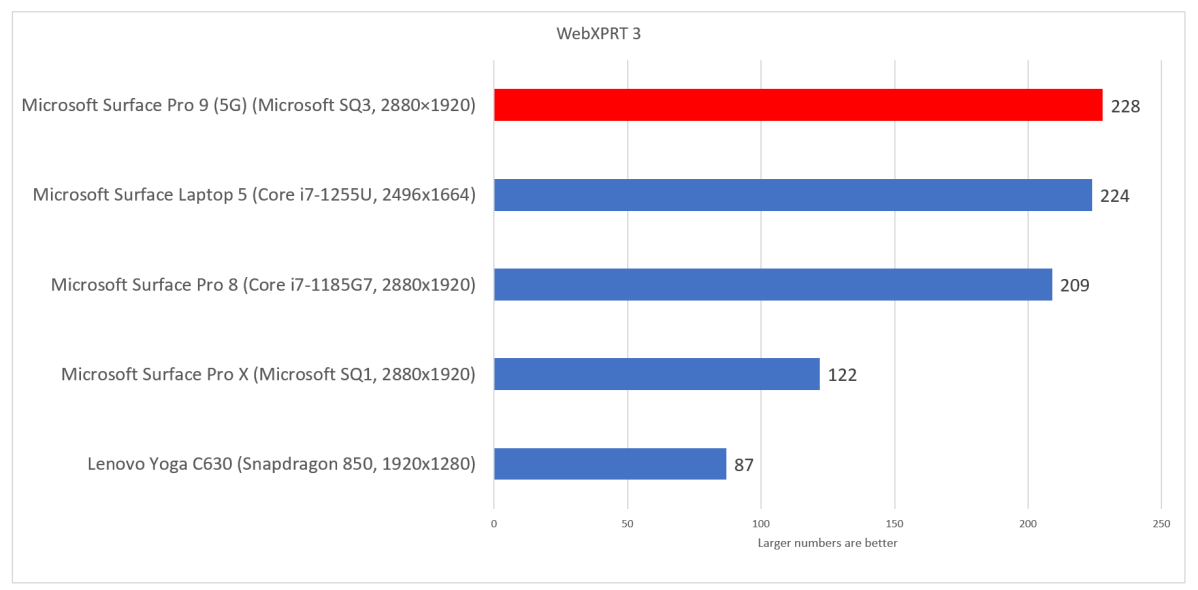
Mark Hachman / IDG
Here’s a more compelling benchmark. If you think of the Surface Pro 9 (5G) as primarily an office machine, running Microsoft 365 (Office) apps and browsing the web — well, that’s what the PCMark 10 Apps test measures. And the Surface Pro 9 (5G) holds its own.
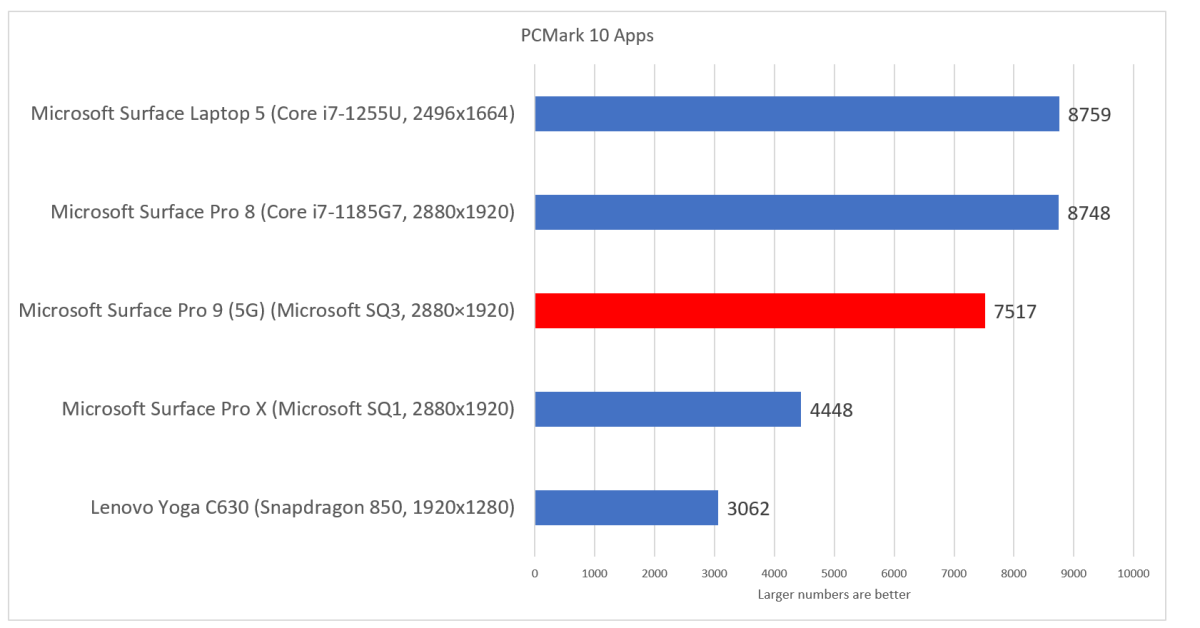
Mark Hachman / IDG
Finally, we used 3DMark’s Night Raid, a cross-platform 3D GPU test, to evaluate how the Adreno 3D core inside the SQ3 fares. Here, it doesn’t quite hold up to the Iris Xe cores used within the Intel Core chips. There’s a significant gap, but it’s not extraordinarily huge, either.
Because of some benchmark database snafus, we weren’t able to directly compare the Lenovo ThinkPad x13s Gen 1 (a clamshell that uses the comparable Snapdragon 8cx Gen 3 processor from Qualcomm) except for this test. The scores are almost exactly equal.
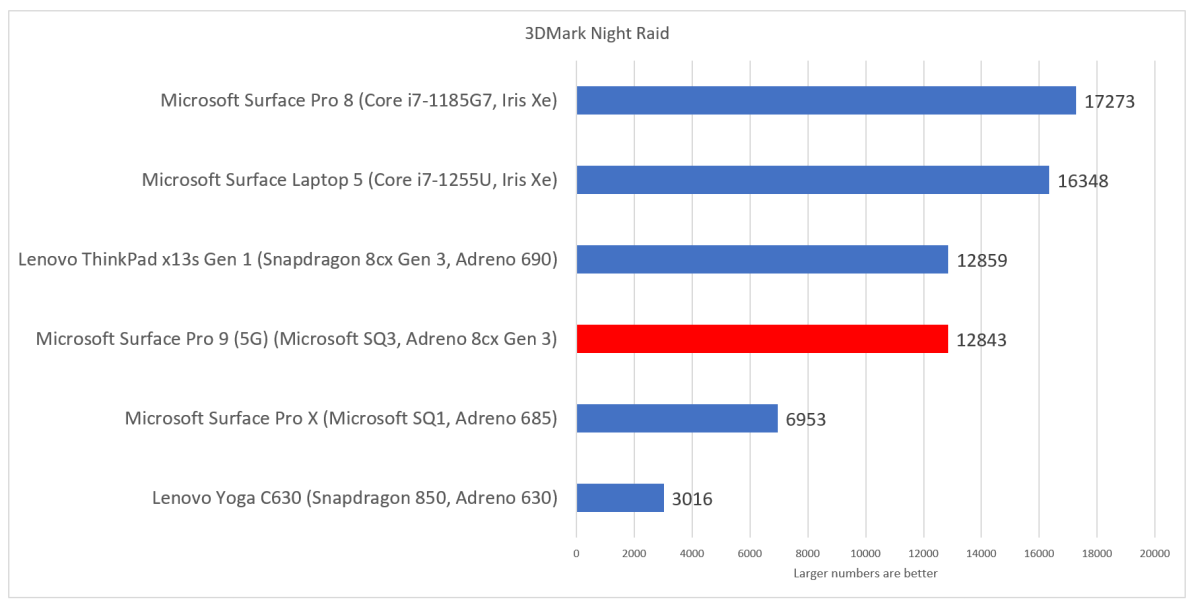
Mark Hachman / IDG
Battery life is certainly a key metric, too, and we use a video rundown test to measure how long the tablet will last when you use it in class, in meetings, and on the couch. We believe that our tests more directly correspond to real-world usage, as our test conditions use a much brighter screen than Microsoft itself does. This is where Arm processors typically shine, as the Surface Pro 9 (5G) does here with about 15.75 hours of real-world battery life.
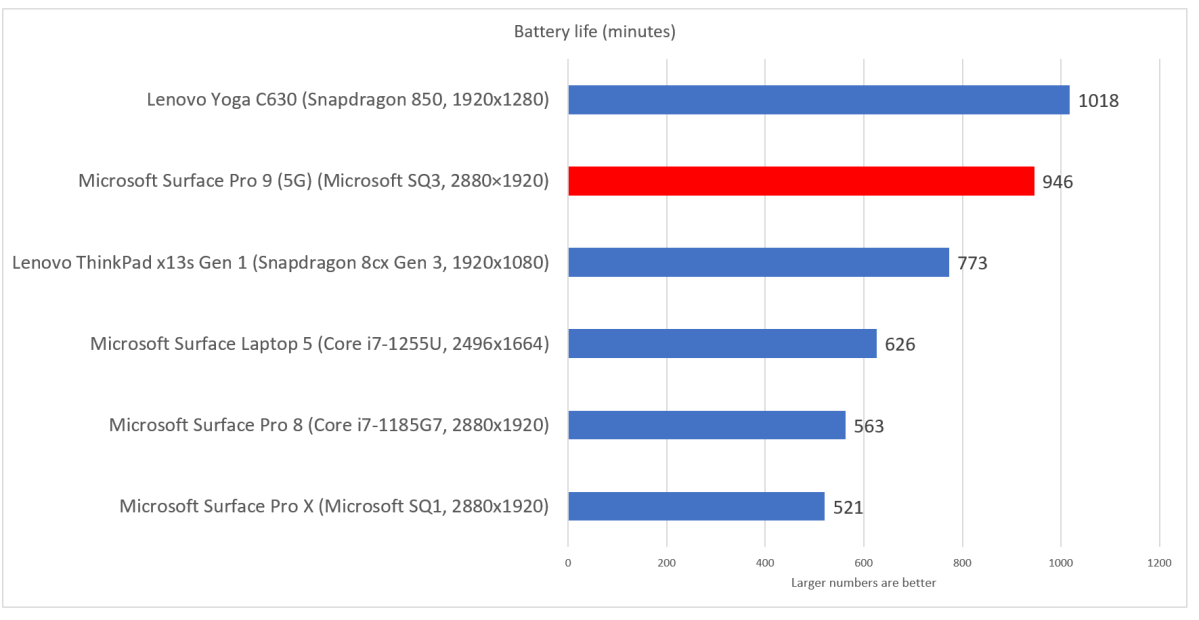
Mark Hachman / IDG
Should you buy the Surface Pro 9 (5G)?
We didn’t extensively test the Microsoft’s tablet for compatibility with modern applications due to time constraints, and that’s traditionally been the weakest point of the Arm argument. You can see that we struggled to get some of our benchmark applications to work, and we’re not going to award an Editor’s Choice award based upon that.
But the thrust of Windows on Arm has always been the core applications, namely Microsoft 365/Office and web browsing, and how they run. All of those load and run as expected. Battery life, the other selling point, has been somewhat superseded by Intel’s Evo platform — by convincing laptop makers to build their clamshells a little thicker and with more battery, they easily extended their run time.
As a tablet, the Surface Pro 9 (5G) sits within a niche, without the ravenous competition of the clamshell notebook space. That gives it breathing room. But, excuses aside, it’s now within striking distance of mainstream Core products. We don’t have the Surface Pro 9 and its Intel Core processor to test, but the Surface Laptop 5 stands in. The tablet’s battery-life argument holds up, and yes, you can argue that you can trade off a bit of lower performance for improved connectivity.
So yes, the Surface Pro 9 (5G) did unexpectedly well. We’re impressed. Is it the best tablet in its class? We don’t know. But yes, we’d recommend that you consider the Surface Pro 9 (5G), and hope for continued competition from Microsoft and Qualcomm in the future.






